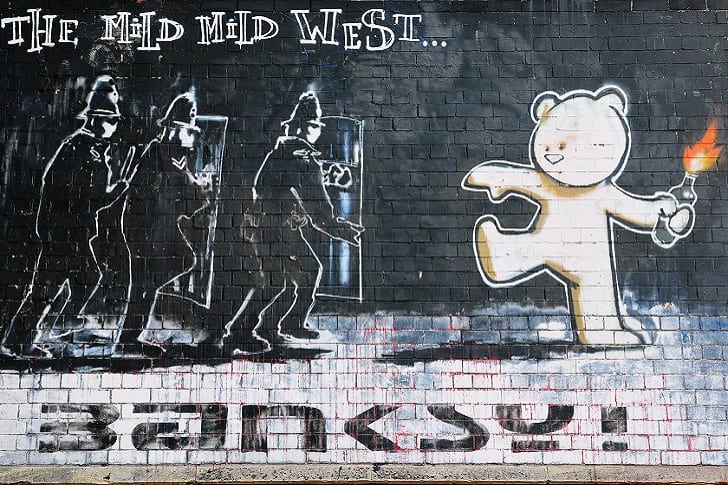
Banksy, now synonymous with provocative street art and political activism, emerged from a contrasting background to his artistic ethos. He hails from Bristol's affluent areas yet felt drawn to the gritty streets of Barton Hill, a neighborhood notorious for its brushes with crime. Despite his father's warnings, he embraced this challenging environment, influencing his artistic identity.
His original pseudonym, Robin Banx, a clever play on 'robbing banks,' reflects the rebellious spirit and the urban environment that shaped him. However, practicality and the desire for a more impactful identity led him to condense this moniker. The result was Banksy—a name that resonates with speed, memorability, and a hint of mystery.
The Start of The Controversy
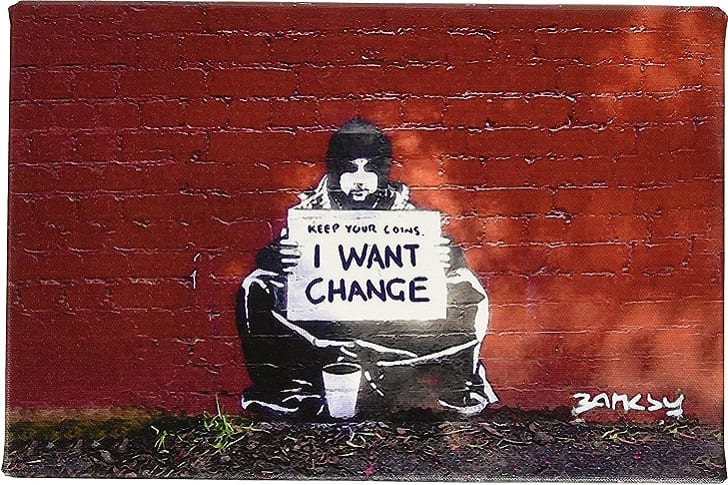
In a twist of irony, Banksy, notorious for his anti-capitalist art, found himself at the center of controversy. His infamous stunt—shredding "Girl With Balloon" right after its auction—sparked debate over his actual stance on capitalism. Though he didn't profit directly from it, the spectacle undoubtedly boosted the value of his future works.
This paradox has led some street art connoisseurs to label Banksy as a capitalist in disguise. Their argument gains weight when considering the staggering sums his other pieces have commanded. It's a compelling thought: the artist who famously critiques the system might be benefiting from it just as much.
A Style Born Out of a Life-Changing Moment
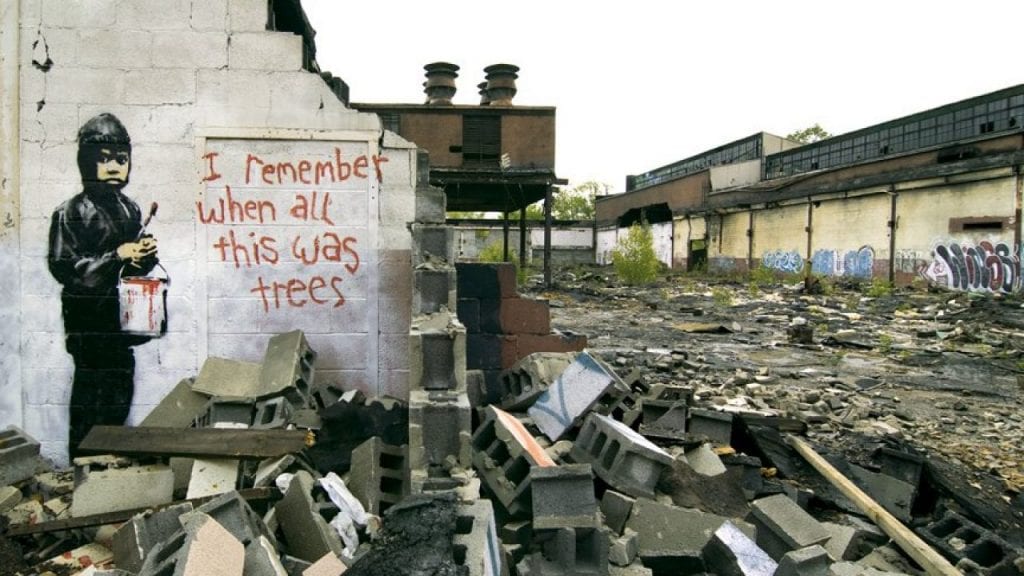
Banksy's iconic style was born from adrenaline and necessity. One heart-pounding day, while graffitiing a train with friends, the transport police arrived. Banksy found himself abandoned in the chaos and forced to hide under an oil truck. There, soaked in engine oil, inches from capture, he had an epiphany.
Time was his enemy. But a glimpse of a stenciled plate sparked an idea as he lay low. Banksy realized that stenciling would allow him to work faster, outpacing the police's grasp. From that moment, he embraced this technique, transforming his art and evasion into an art form in itself, a signature that would define his career.
A Budding Mystery in the Art World
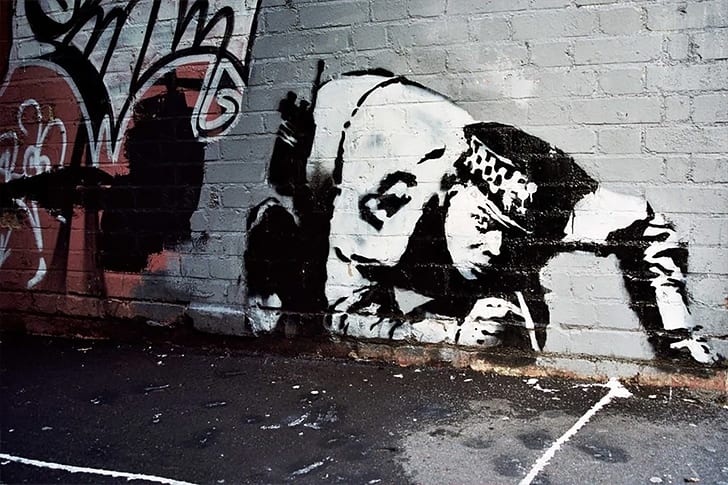
Long before Banksy's fame skyrocketed, he cleverly embraced anonymity, not just as a shield against legal troubles but as a brilliant marketing strategy. In the UK, where graffiti can lead to hefty fines or jail time, staying out of the limelight was crucial for a street artist whose work often treads the line of legality.
But beyond evading arrest, Banksy saw the allure in mystery. By concealing his identity, he fueled public curiosity and buzz around his persona. This strategy coincided perfectly with the late 1990s, a time when his creations began to increase in cityscapes, turning anonymous streets into galleries of provocative, clandestine art.
Behold Banksy's Dark World Through His Own Disneyland
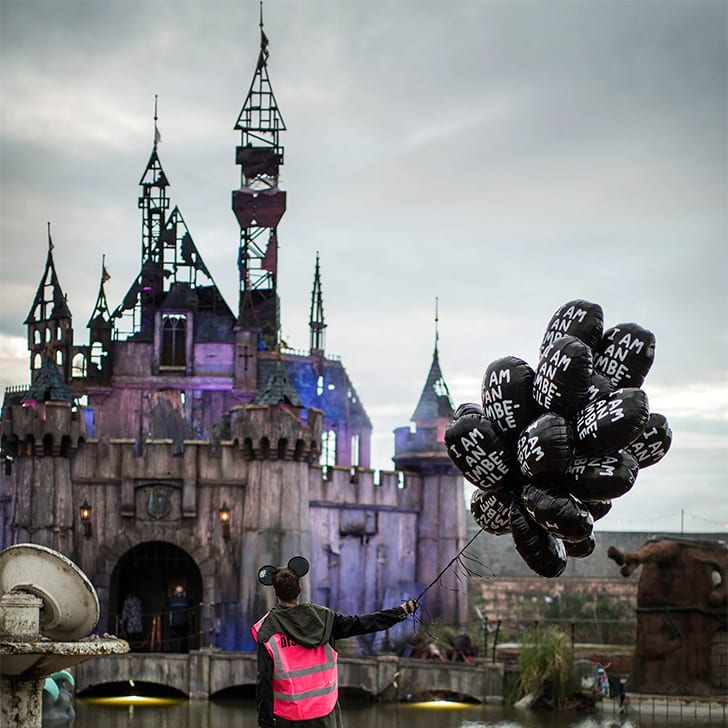
Banksy, infamous for his incisive street art, unveiled a monumental project in 2015: Dismaland. This dystopian theme park, a stark contrast to Disneyland's cheerful and family-oriented fantasy and image, emerged on a desolate seaside resort in Somerset, England. Far from a mere pop-up exhibit, Dismaland offered a full-blown, immersive experience featuring Banksy's work alongside 58 other artists.
This apocalyptic wonderland opened for just five weeks and provided visitors with a unique, perhaps unsettling, reinterpretation of a theme park. It wasn't just art but a statement – a grim, thought-provoking exploration of society's underbelly, wrapped in the guise of a twisted, darkly humorous attraction.
No Smiles Allowed at Dismaland
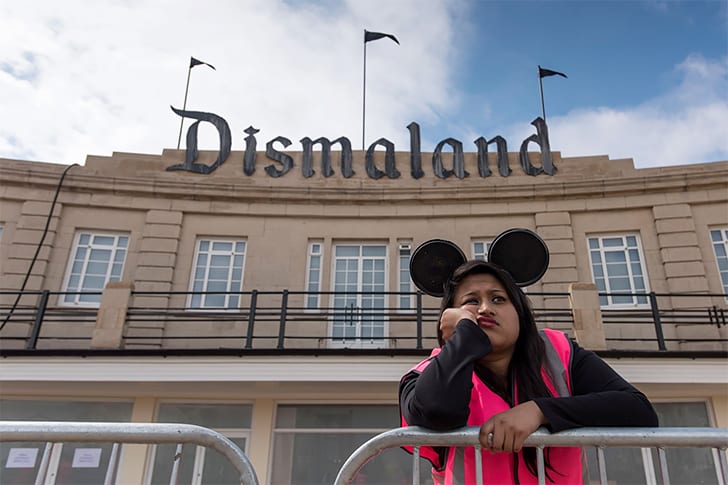
Dismaland, Banksy's ironic theme park, flips the typical joyous experience on its head. As visitors enter, they are met with surly staff, embodying British stereotypes of unfriendly customer service, a stark contrast to the usual cheery greetings. This place isn't about fun; it's a satirical twist on entertainment.
Roaming guards playfully enforce the park's dismal theme, even doling out whimsical 'punishments' like hopping in place for not being gloomy enough. It's an absurd, almost comical setting where the usual theme park delights are intentionally absent. If you're seeking a traditional holiday getaway, you might want to opt for a regular resort instead.
Banksy's Unconventional Rise to Fame
![]()
A master of mystery and satire, Banksy has etched his mark on 21st-century pop culture, becoming an icon of the era. His stealthy rise peaked in 2010 when Time Magazine hailed him among the world's most influential, alongside names like Steve Jobs, Lady Gaga, and Barack Obama.
In a defiant twist, Banksy's feature showed him with his face shrouded in a paper bag - a self-submitted image that screams his unique brand of anonymity. In his tribute, celebrity street artist Shepard Fairey applauded Banksy's dedication to democratizing art, bringing it from elite galleries to the everyday streets, making it a conversation for all.
Unmasking the Artist: From Hanksy to Lucas
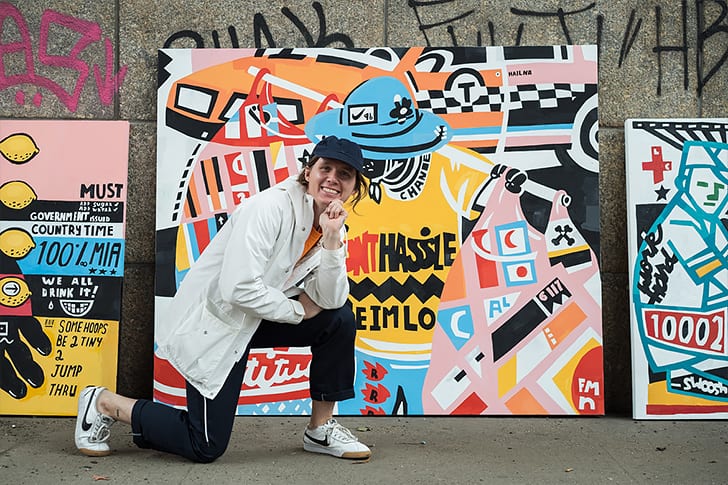
Hanksy, a New York City artist inspired by Banksy, rocketed to fame in 2011 with his unique twist: blending Tom Hanks' face with Banksy-style graffiti. This clever fusion birthed his interesting moniker, Hanksy. Yet, behind the playful parody lay a more profound artistic ambition.
The man behind Hanksy is Adam Lucas, who eventually shed his humorous persona, eager to be recognized for more than meme art. While he steps into the light, Banksy remains a mystery. Though shrouded in mystery, some believe they're inching closer to unveiling the true face behind the Banksy name, keeping the art world abuzz with speculation.
An Effort to Demystify Banksy
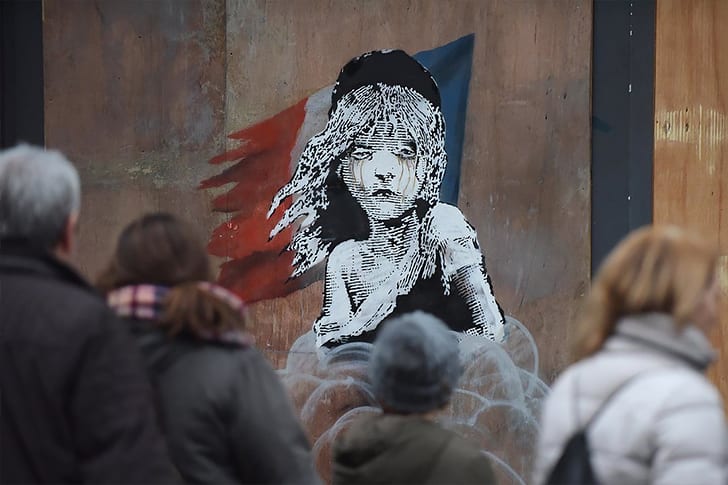
In a daring blend of criminology, mathematics, and geographic profiling, Queen Mary University's scientists embarked on a mission to demystify the identity of the elusive street artist Banksy. Their approach? Mapping out Banksy's known works across Bristol and London, then cross-referencing these locations with the hangouts of potential Banksys.
Their intriguing findings, showcased in the 2016 Journal of Spatial Science, zeroed in on a prime suspect. Steve Le Comber, part of this intrepid team, confidently backed their educated guess. This unique intersection of art and science highlighted not only Banksy's enigma but also the innovative ways people could try to uncover his identity.
The Banksy-Gunningham Mystery
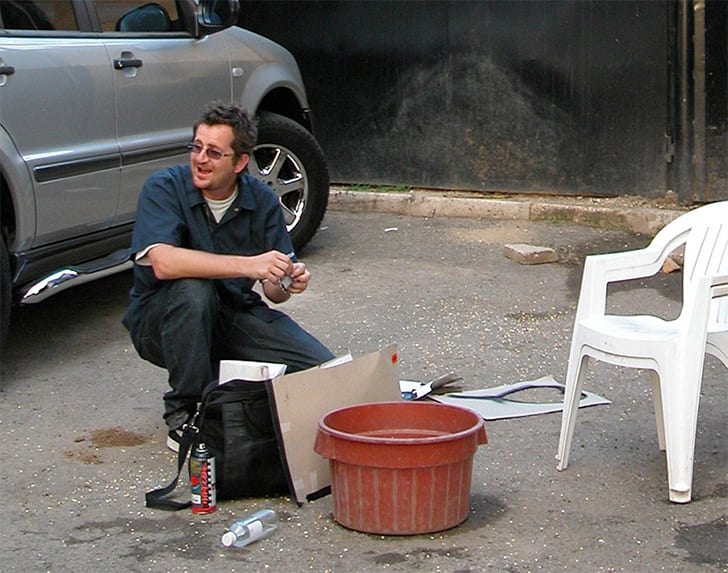
Is Robin Gunningham the elusive Banksy? Speculation has swirled since 2008 following a Daily Mail report linking him to the notorious street artist. This Bristol native's artistic endeavors, whether Banksy's or not, are attracting serious attention—and cash.
In 2018, one of Gunningham's album sleeve drawings was auctioned for a hefty £4K ($5,242), likely fueled by the Banksy connection. Astute observers note striking similarities in their typography and lettering styles. The resemblance is uncanny enough to make anyone wonder if they're witnessing Banksy's work firsthand. For art enthusiasts and collectors, the Gunningham-Banksy intrigue is more than just a curiosity—it's a potentially lucrative investment.
Is Banksy Among Us?
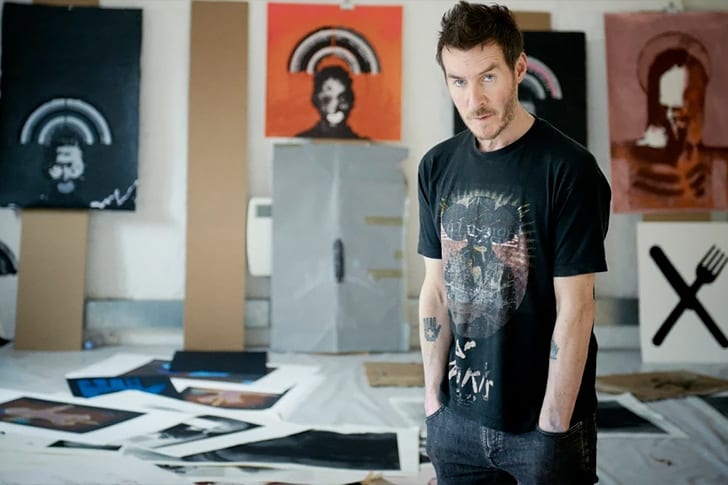
On the streets of Bristol, another intriguing character emerges as a potential Banksy: Robert Del Naja of Massive Attack. The man's journey as a street artist parallels the timeline of Banksy's rise. His early graffiti work with various collectives and a particularly revealing clue, an album cover he designed in Banksy's iconic stencil style, fuels speculation.
The twist? Both Robert and Banksy acknowledge a friendship, possibly a clever ruse to divert the ever-growing curiosity about Banksy's true identity. This connection between music and street art blurs the lines, leaving us wondering: Are they distinct artists or masterfully crafted personas of the same enigmatic genius?
The Banksy-Guetta Conspiracy
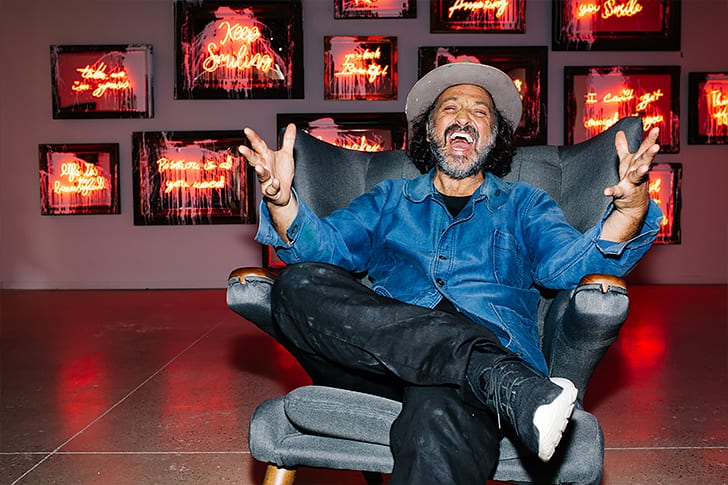
Thierry Guetta, known as Mr. Brainwash in the "Exit Through The Gift Shop" documentary, is stirring up intrigue. There's buzzing speculation that his displayed mediocrity was a clever ruse, positioning him as Banksy, masterfully cloaked behind a façade of ordinariness. This theory tickles the imagination, especially given Banksy's penchant for playful subterfuge.
It's an idea that dances on the edge of plausibility, aligning seamlessly with Banksy's trademark humor. Yet, doubts linger, as art critics have consistently lambasted Thierry's work, suggesting his lack of artistic flair might be more than just an act. The mystery deepens in this compelling tale of the contemporary art world's most famous intrigue.
A Glimpse from the Past?
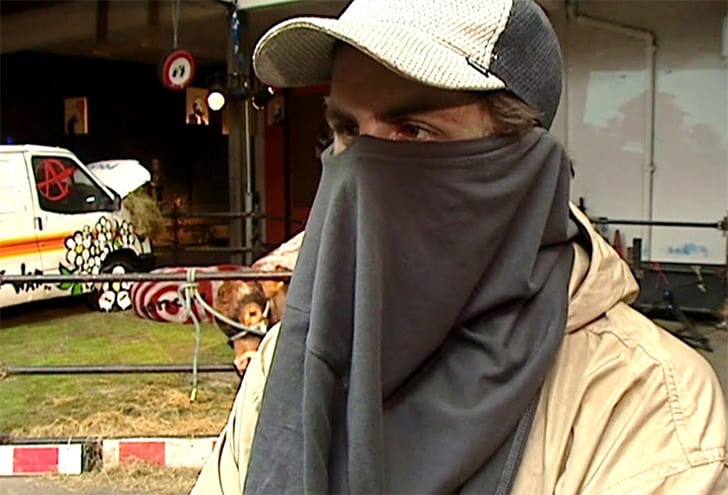
In 2003, a televised interview featured a self-proclaimed Banksy, his identity shrouded by a black T-shirt over his face. Captured during the Turf War exhibit era, the footage, resurfaced in 2019, shows him crafting graffiti later verified as authentic. This intriguing relic raises questions as the now-retired interviewer remains uncertain about the interviewee's true identity.
This uncertainty continues to shroud the British street artist, who faced a significant legal setback in 2020, possibly influencing his stance on anonymity. The mystery endures: was the man behind the mask the real Banksy, or just another intriguing and confusing piece in his mysterious puzzle?
Banksy's Messy Legal Battle
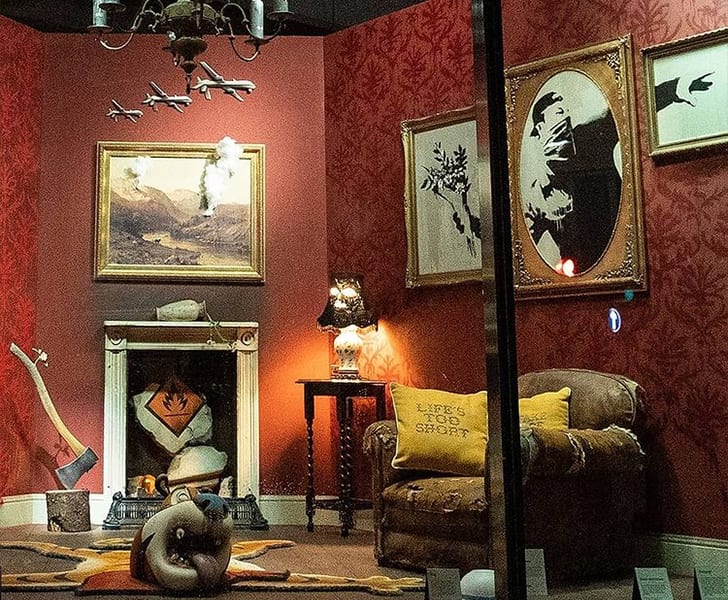
Banksy faced a critical blow in a striking turn as Full Colour Black, a greetings card company, triumphs in a legal clash over his iconic artwork, "Rage, The Flower Thrower." Dazed magazine reports that after a two-year tussle, the company now holds the rights to use this famous piece for their products.
Key to the ruling was Banksy's elusive identity and his choice to paint on private properties. This verdict doesn't just impact one artwork; it casts a shadow over Banksy's entire collection, risking commercial exploitation without his consent. This decision blurs the lines between street art's rebellious spirit and the commercial world's demands.
More Than the Profit, Banksy's Watchful Eyes from the Sidelines
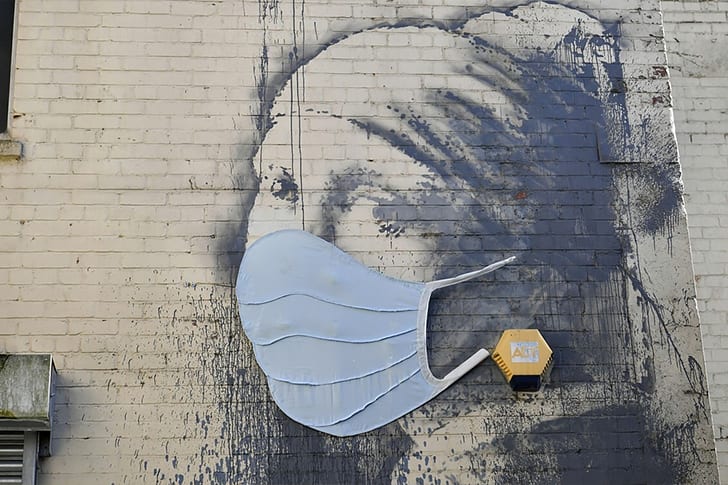
In a world where fame often compromises privacy, Banksy remains a mystery, steadfast in guarding his anonymity even when he faced adversities such as the lawsuit. This mysterious artist watches as others profit from his renown, seemingly unfazed. Rather than succumbing to the pressures of revelation, he dedicates himself to crafting art that captivates and soothes in challenging times.
His work, a beacon of intrigue and solace, continues to resonate deeply, transcending boundaries and sparking conversations worldwide. In this turbulent era, Banksy's commitment to his secret identity not only adds to his allure but also reinforces his art's powerful, enduring impact.
Banksy’s Tribute to Workers
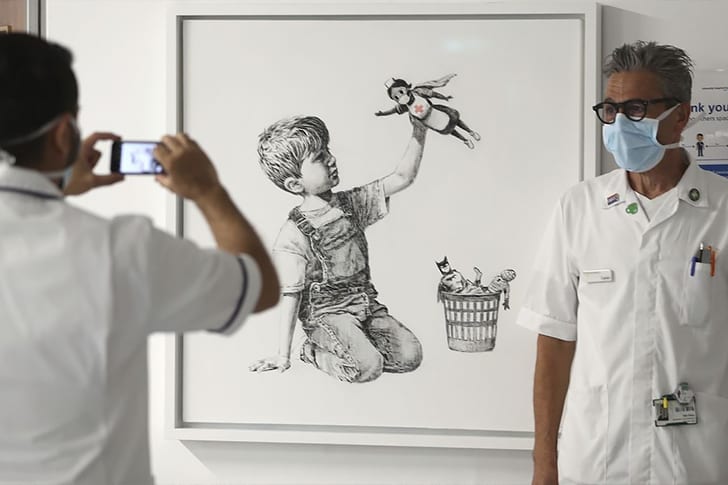
In a heartwarming gesture, Banksy's artwork, "Game Changer," made its debut at Southampton General Hospital in May 2020. This poignant black-and-white piece captures a young boy playing with a nurse superhero figurine while traditional superheroes like Batman are relegated to a bin.
With a cape and face mask, the nurse symbolizes real-world heroism. Reportedly accompanying the artwork, Banksy's note expressed deep gratitude towards medical workers. This thoughtful tribute not only uplifted spirits but also took on a charitable aspect. The piece was auctioned to support the National Health Service, showcasing art's power to honor, thank, and aid those who selflessly serve society.
Urban Artwork Sparks Joy Among Passersby
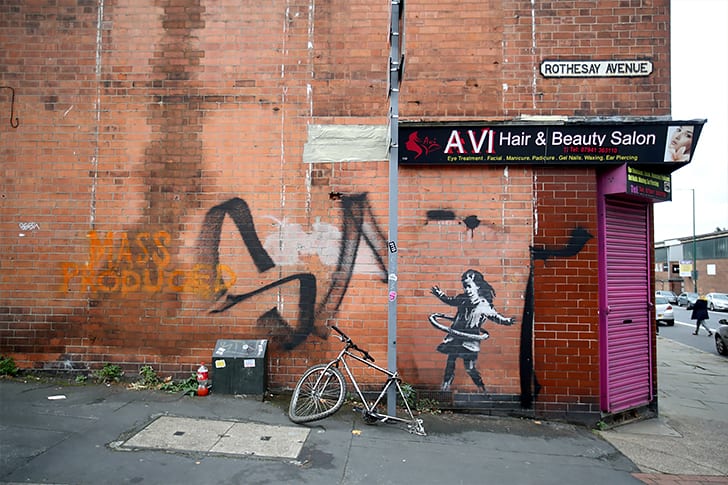
In the heart of Nottingham, October 2020 saw a fresh burst of positivity from the elusive street artist. Outside a beauty salon, a new black and white stencil appeared featuring a little girl lost in the joy of hula-hooping. This simple yet inspiring artwork brought a wave of delight and optimism, offering a bright spot in challenging times.
Banksy, known for his distinctive artistic style, continues to captivate the world to this day. His art mirrors society's many facets: the grim, the heart-wrenching, and occasionally, a touch of whimsy. Each piece, a reflection of the times, keeps the world guessing and, more importantly, feeling.
Banksy's Evolution From Streets to Screen
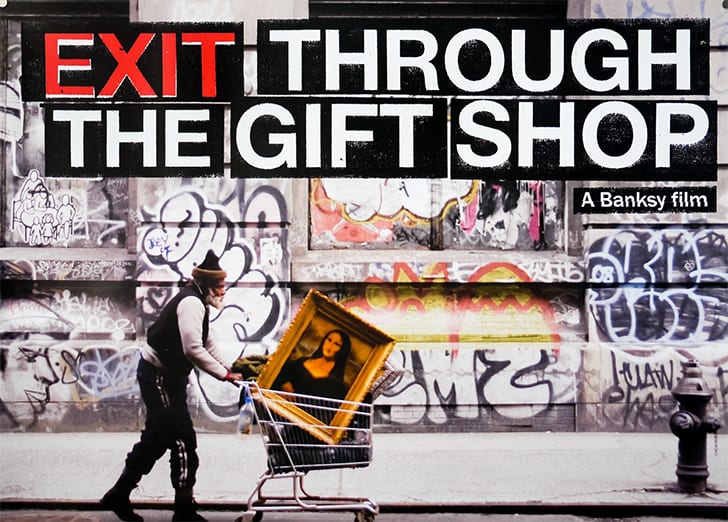
Having conquered the streets with his provocative art, Banksy turned his gaze to the world of film. In 2010, he surprised everyone with "Exit Through the Gift Shop," a documentary as unconventional as his murals. The film introduces us to Thierry Guetta, a French immigrant offering an intimate peek into the secretive realms of graffiti artists.
This isn't just a story about street art's journey to gallery walls; it's a tale of transformation. How street art, once seen as vandalism, ascended to high art, reshaping the art world's landscape and turning anonymous artists into coveted icons. Banksy masterfully uses the camera to question art's commercialization.
Banksy's Vision in 'Devolved Parliament'
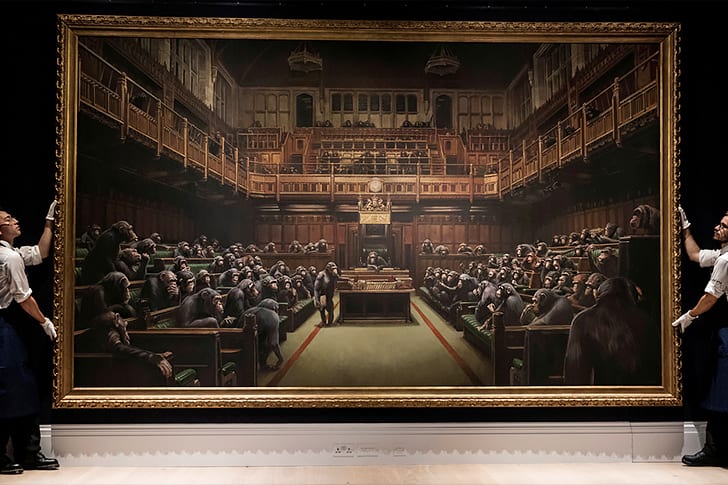
Banksy's "Devolved Parliament" stands as a testament to his foresight in political satire. It fetched a staggering $12.2 million in 2019, marking it as his priciest piece. Painted in 2009, long before Brexit convulsed the United Kingdom, it portrays British MPs as apes, a sharp critique of political pandemonium.
Its display at Bristol Museum & Art Gallery, coinciding with the UK's intended Brexit date, wasn't just timely but prophetic. This artwork not only spotlights the turmoil in the country but also underscores the artist's uncanny ability to capture the zeitgeist, cementing the piece's relevance and impact well beyond its creation.
'Keep It Spotless' is the Second Priciest Masterpiece
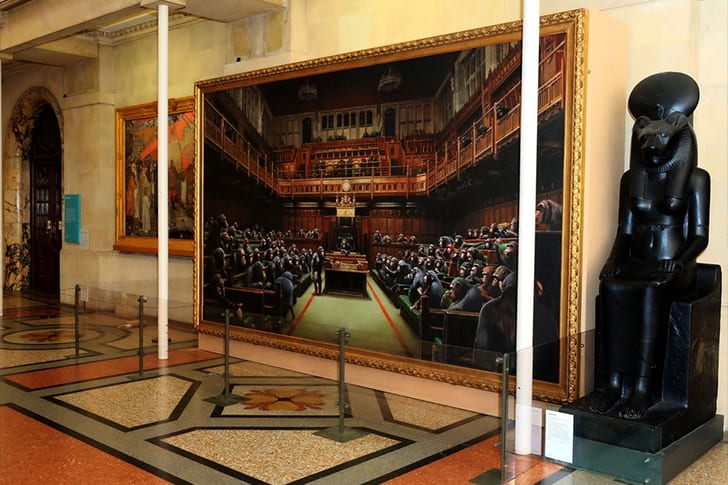
Banksy's "Devolved Parliament" shattered records, surpassing the $1.7 million fetched by "Keep It Spotless" on Valentine's Day 2008. Both artworks share more than just hefty price tags; they are vivid commentaries on contemporary issues. "Keep It Spotless" captures an intriguing scene: Leanne, a hotel housekeeper, tidies up, lifting a Damien Hirst painting.
This visual echoes Banksy's earlier work, "Sweeping It Under the Carpet," renowned for its metaphorical critique of society's tendency to ignore pressing concerns, exemplified by a crisis in Africa. The sale marked a significant moment, not just in Banksy's career but in the art world's engagement with social commentary.
Banksy's Generous Stance

Defying the norm, Banksy openly addresses critiques that point out the unconventional in his artworks. In a candid email to the New Yorker, he reveals a unique approach: distributing thousands of his creations for free. Why? He believes in the paradox of creating poverty-themed art while accumulating wealth.
Banksy's philosophy extends beyond giving; he invites everyone to freely use his images, with a single condition: no commercial gain. His website even offers high-resolution downloads, allowing admirers to print and cherish his creations at home. This gesture not only democratizes art but also reinforces Banksy's commitment to accessibility and authenticity in his artistic expression.
The Rebel vs. the Hypocrite in Banksy
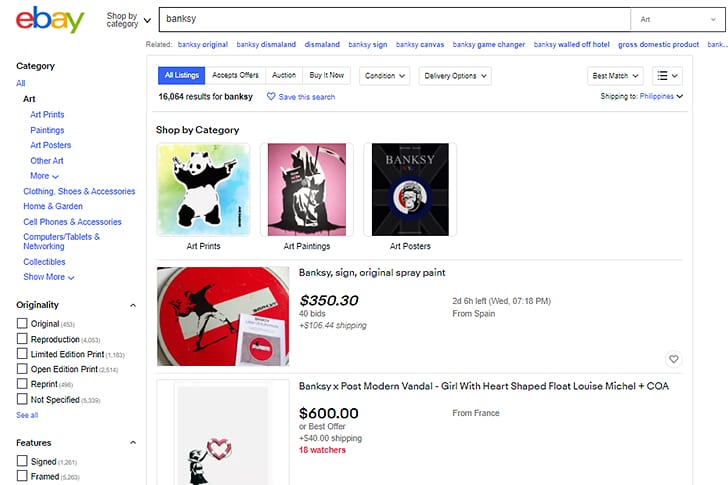
Banksy, often viewed as a rebel in the art world, faces a unique dilemma. His street art, meant to be public and free, ironically becomes a commodity for others' profit. While some label him a hypocrite, the real issue lies with those who remove his creations from their urban canvases, selling them for fortunes.
The irony deepens with a simple eBay search, revealing a flood of Banksy imitations. Here, everyone from amateur photographers to savvy art dealers cashes in on his fame. Yet, Banksy remains unrewarded mainly. In this twist, Banksy emerges not as a hypocrite but as an unwilling participant in the commercialization of his own rebellious art.
Banksy's Breakthrough: Art, Anarchy, and Audacity

In 2003, Banksy rocketed to fame with his Turf War exhibition, drawing crowds including police and celebrities like Jamie Oliver and DJ Sara Cox. At 28, he unabashedly shared his raw views on art with Artnet, dismissing painting as tedious and vowing to pursue more engaging endeavors.
His critique extended to the elitist gallery system, challenging the notion of art's monetary value controlled by millionaires. True to his words, Banksy embarked on a global tour, playfully disrupting prestigious museums. His actions weren't just provocative statements but audacious acts that solidified his status as a revolutionary figure in the art world.
Banksy's Daring Museum Capers
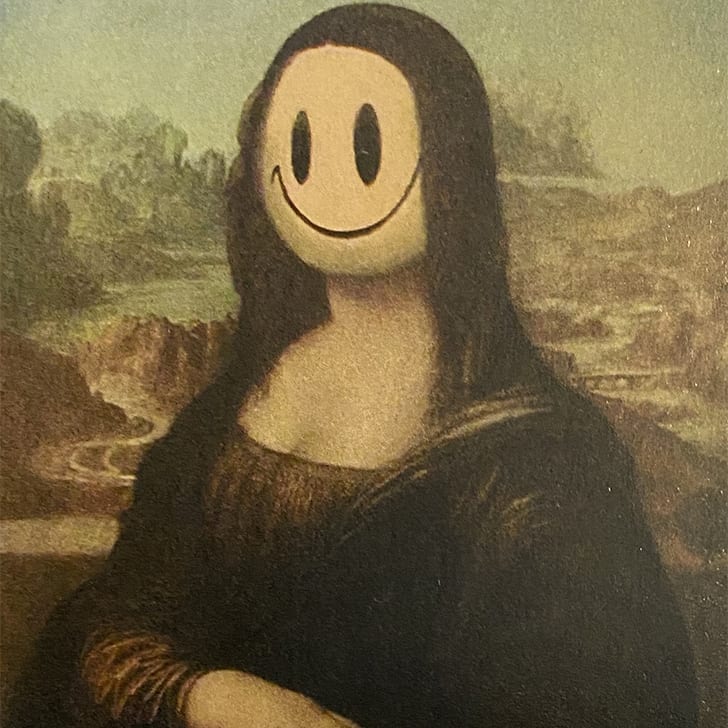
Shrouded in disguise, Banksy embarked on a daring year-long adventure through the world's most prestigious museums, including Paris's Louvre and New York's MoMA. Far from a mere spectator, he audaciously left his own mark. At the Louvre, he cheekily reimagined the Mona Lisa, adorning her with a smiley face—a piece that later fetched £56K ($70K) at auction.
His New York escapade was equally bold, surreptitiously placing a portrait of a woman in a gas mask within MoMA's walls. These stunts weren't just pranks; they were statements, challenging the norms of the art world and leaving an indelible impression on its history.
'Girl With Balloon' Magic Is Unending
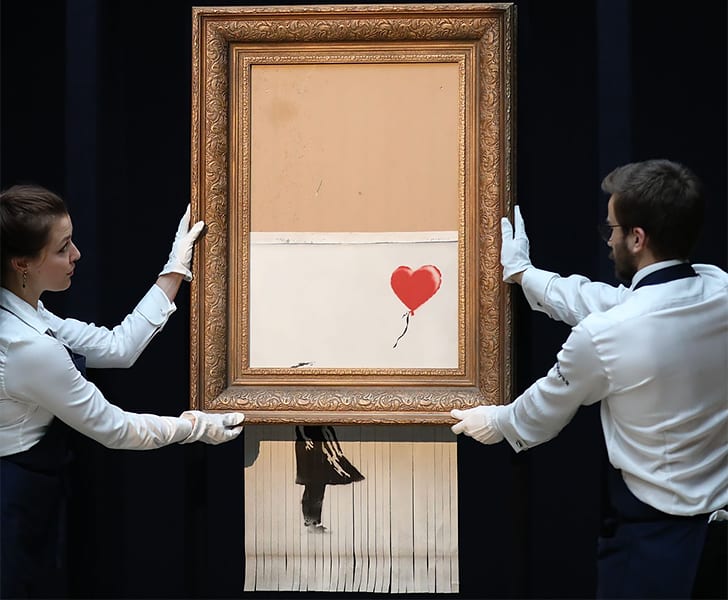
Banksy's iconic 'Girl with Balloon,' a stencil of a child reaching for a red, heart-shaped balloon, transitioned from street art to a framed piece in Sotheby's 2018 auction. The room buzzed with anticipation as affluent bidders pushed the price sky-high.
The atmosphere was electric, a blend of opulence and excitement, as the bids soared to an astonishing £860K ($1.2 million), eventually totaling a cool £1 million ($1.4 million) with the premium. The gavel struck, sealing the deal amidst a chorus of cheers. Little did the audience know, they were mere moments away from witnessing one of the most unforgettable stunts in art auction history...
A Daring Deception Stuns Crowd
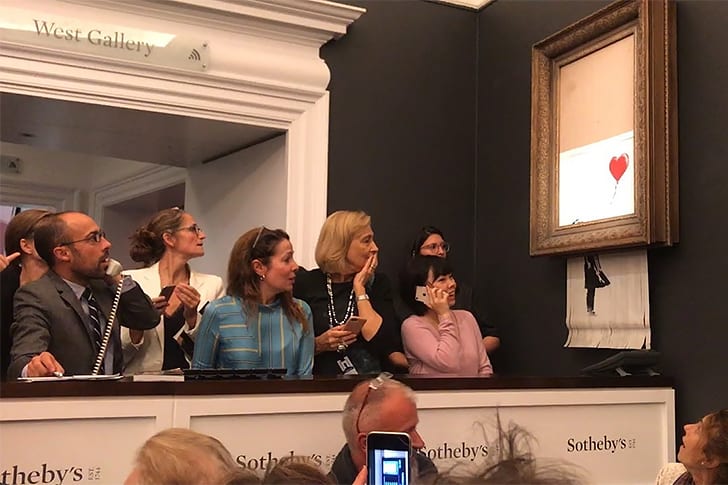
In a jaw-dropping turn of events, the artwork came to life within a gallery, self-destructing as a hidden contraption worked its magic. Gasps of astonishment filled the room as the artwork began shredding itself before everyone's eyes. Half of the masterpiece was irreparably altered when the gallery staff rushed to the scene.
Whispers of being "Banksy-ed" echoed through the crowd. The suspicions weren't unfounded. He took to Instagram, revealing a video that exposed a man installing blades into the frame years before the painting hit the auction block. Alongside the footage, Banksy shared a profound quote from Pablo Picasso, "The urge to destroy is also a creative urge."
A Transformative Experience for Everyone
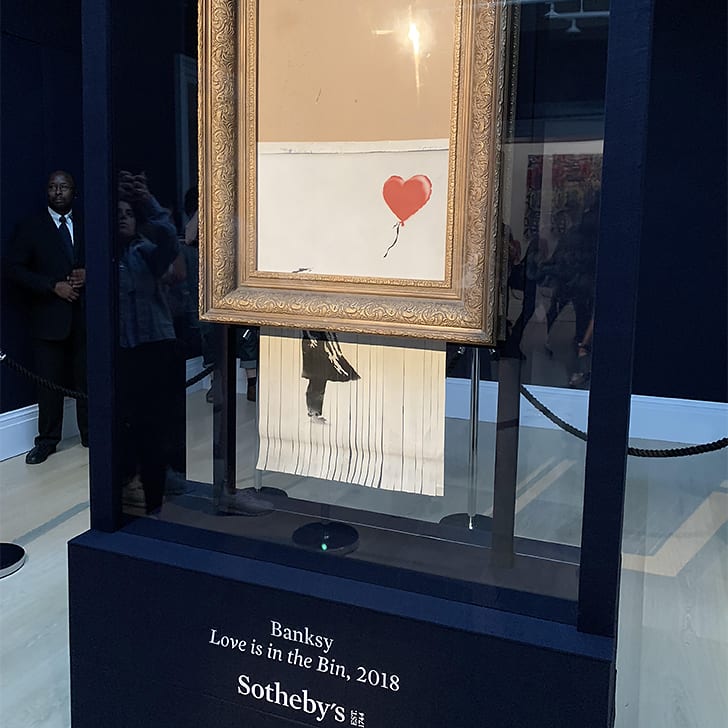
Banksy breathed new life into the iconic "Girl With Balloon." After its dramatic shredding at an auction, the artwork was reborn as "Love Is In The Bin," a testament to his unpredictable creativity. The buyer, initially stunned by the unexpected turn of events, ultimately embraced the piece as a unique slice of art history.
But this wasn't the first transformation of Banksy's iconic image. Since its initial appearance in the early 2000s, the image has served as a canvas for diverse interpretations. Some see it as a symbol of hope and the arrival of love, while others perceive it as a representation of lost innocence.
Banksy's Daring Artistry in Israel
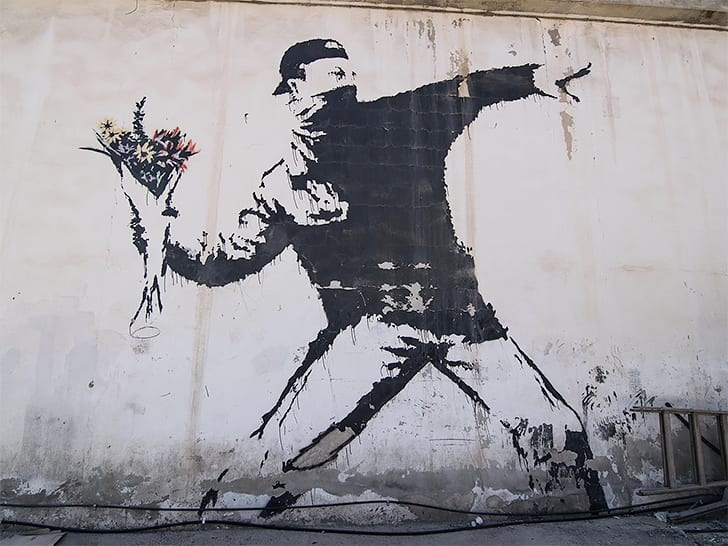
Fresh from his museum tour, Banksy embarked on a bold mission in 2005, venturing into Israel with spray paint and a powerful message. Along the hotly disputed West Bank barrier wall, he skillfully stenciled captivating escape-themed artworks that left spectators in awe. The question on everyone's lips: How did he evade capture in this high-stakes endeavor?
Jerusalem bore witness to another iconic creation: "Rage, Flower Thrower," portraying a man tossing a flower instead of a Molotov cocktail, a powerful statement against warfare. Banksy's audacious artistry in Israel is a testament to his daring spirit and commitment to spark change through his work.
The Art World's Guardian Angel
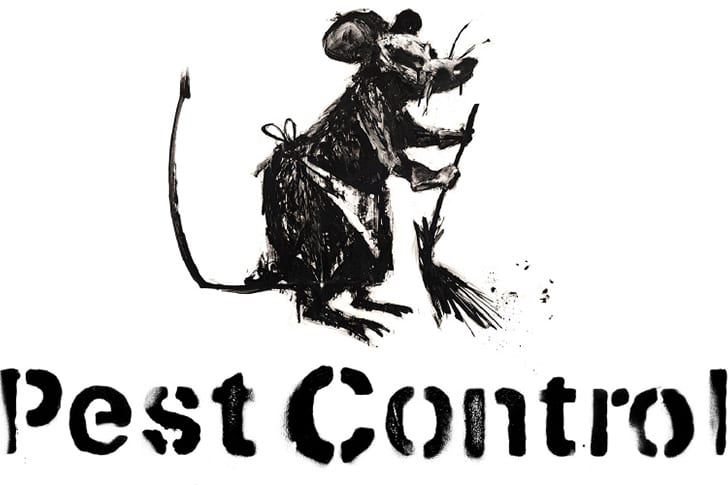
In a bid to shield art enthusiasts from falling prey to counterfeit artworks, Banksy devised an ingenious solution—Pest Control. This aptly named office undertakes the crucial task of verifying the authenticity of his creations, furnishing proud owners with certificates as proof. Yet, Pest Control isn't merely a gatekeeper; it also plays the role of a protective parent and legal guardian.
Its dedicated team manages the artist's paperwork and valiantly intercepts any hate mail directed his way. However, a shroud of mystery still surrounds Banksy's financial pursuits. How, you wonder, does the elusive artist sustain himself? More intriguingly, just how vast is his wealth?
Unraveling Banksy's Hidden Wealth
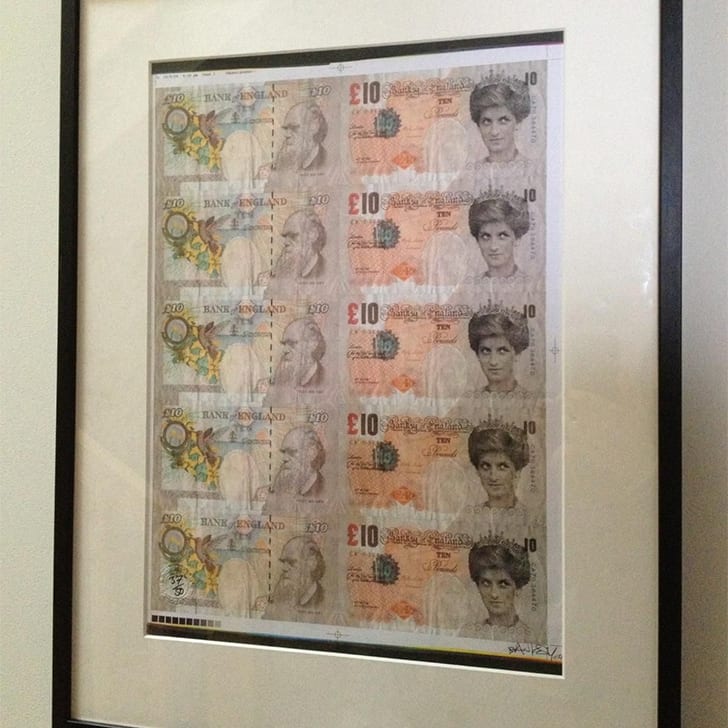
Banksy's actual net worth remains shrouded in mystery, a secret locked away from the prying eyes of the world. While online speculations place his fortune between $20 million and $50 million, these figures are but educated guesses. His earnings, however, offer a glimpse into his financial world.
It's likely that Banksy conducts his art sales directly from his studio, facilitated by Pictures on Walls, an artists' collective co-founded by him and Pest Control. The price of a signed print of his iconic works can range from $20K to $40K, with Banksy taking a significant share of the proceeds. Currently, Pest Control keeps his work off the market.
Inside Banksy's Secret Art Arsenal
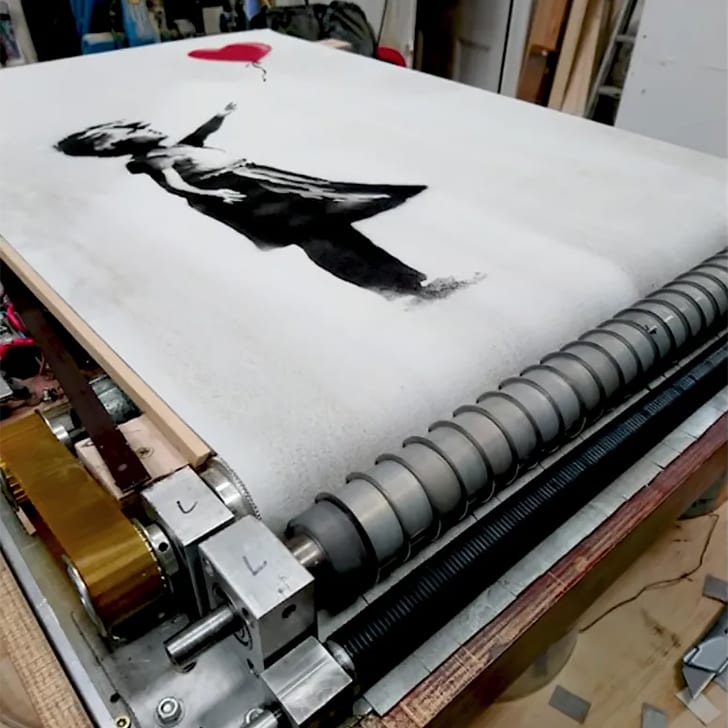
When Banksy unveiled a video revealing his audacious attempt to shred his iconic artwork, "Girl With Balloon," during an auction, it offered a rare glimpse into his clandestine creative realm. Surprisingly, his workspace appeared remarkably ordinary, resembling any conventional artist's studio, adorned with printing machinery and an array of paints.
Banksy had meticulously equipped his workshop with the tools necessary to construct a covert, battery-operated shredder ingeniously designed to attach to his artwork should it ever sell. While the identity of this artist remains a mystery, his gesture of granting us a peek into his enigmatic sanctuary hints at the dichotomy between his clandestine persona and his public artistry.
